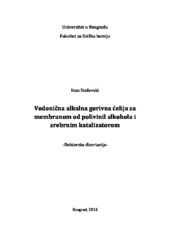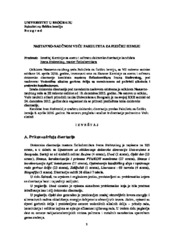Приказ основних података о дисертацији
Vodonična alkalna gorivna ćelija sa membranom od polivinil alkohola i srebrnim katalizatorom
Hydrogen alkaline fuel cell with poly(vinyl alcohol) membrane and silver catalyst.
| dc.contributor.advisor | Miljanić, Šćepan | |
| dc.contributor.other | Mentus, Slavko | |
| dc.contributor.other | Kačarević-Popović, Zorica | |
| dc.contributor.other | Šljukić Paunković, Biljana | |
| dc.creator | Stoševski, Ivan | |
| dc.date.accessioned | 2016-09-03T19:16:24Z | |
| dc.date.available | 2016-09-03T19:16:24Z | |
| dc.date.available | 2020-07-03T09:33:36Z | |
| dc.date.issued | 2016-07-05 | |
| dc.identifier.uri | http://eteze.bg.ac.rs/application/showtheses?thesesId=3796 | |
| dc.identifier.uri | https://nardus.mpn.gov.rs/handle/123456789/6444 | |
| dc.identifier.uri | https://fedorabg.bg.ac.rs/fedora/get/o:12749/bdef:Content/download | |
| dc.identifier.uri | http://vbs.rs/scripts/cobiss?command=DISPLAY&base=70036&RID=48116495 | |
| dc.description.abstract | Glavna ideja ovog rada je razvoj koncepta vodonične alkalne gorivne ćelije zasnovane na upotrebi komponenata napravljenih od jeftinih materijala. Kao polazni materijali za pripremu elektrolita matriks-tipa odabrani su polivinil alkohol (PVA) i kalijum-hidroksid (KOH), dok je za sintezu katodnog, srebrnog katalizatora za redukciju kiseonika korišćen srebro-nitrat. Za razliku od niskobudžetnih, katode i membrane, kao anoda je korišćena komercijalna platinska elektroda. Smatrano je da anodna reakcija oksidacije vodonika ima znatno manji uticaj na efikasnost ćelije od reakcije redukcije kiseonika i da će se daljim istraživanjem relativno lako naći jeftina zamena ako se ovakav koncept pokaže ispravnim. U prvoj fazi istraživanja, polimerne PVA membrane su sintetisane radijaciono-hemijskom metodom, upotrebom γ-zračenja, i hemijskom metodom, uz upotrebu različitih umreživača (glutar aldehida i polietilen diglicidil etra). Zatim je ispitivan uticaj parametara sinteze na membranska svojstva koja su od značaja za upotrebu u gorivnim ćelijama: jonska provodljivost, permeabilnost za gasove, kao i hemijska i termalna stabilnost. Akcenat je stavljen na povećanje provodljivosti, oslanjajući se na činjenicu da nedehidratisane membrane poseduju veći stepen bubrenja vodom. Na osnovu toga, polazna pretpostavka je bila da će takve membrane imati i veći stepen bubrenja elektrolitom i samim tim i veću provodljivost. Pretpostavka se pokazala ispravnom, jer je provodljivost nesušenih membrana veća od sušenih za red veličine (dostiže vrednost do 0,34 S cm-1 na sobnoj temperaturi), što je postignuto i radiolitičkom i hemijskom metodom. Takođe, membrane su pokazale zadovoljavajuću stabilnost održavajući visoku provodljivost u periodu dužem od godinu dana, tokom kojeg su bile izložene jakoj bazi. Drugi deo istraživanja se sastojao u radijaciono-hemijskoj sintezi srebrnih katalizatora i elektrohemijskom ispitivanju njihove efikasnosti za reakciju redukcije kiseonika. Poređenjem njihovih gustina struja na određenim nadnaponima sa literaturnim podacima pokazalo se da poseduju zadovoljavajuće aktivnosti za ovu reakciju. U poslednjoj fazi istraživanja akcenat je stavljen na pripremu gorivnih ćelija, sastavljenih od sintetisanih membrana i katalizatora, i na ispitivanje njihovih efikasnosti. Ova faza uključuje različite metode pripreme membransko-elektrodnog sklopa i pronalaženje optimalnog sastava katalitičkog sloja... | sr |
| dc.description.abstract | The main idea of this thesis is development of hydrogen alkaline fuel cell concept that includes a fuel cell made of low-cost materials. Basic precursor materials that were chosen are poly(vinyl alcohol) and potassium-hydroxide for the preparation of a matrix electrolyte, and silver-nitrate for the synthesis of cathodic, silver catalyst for oxygen reduction reaction. While the cathode and membrane comprise of cheap materials, the anode was commercial, platinum-based electrode. The reason for this lies in assumption that anodic reaction of hydrogen oxidation influences the fuel cell efficiency much less than oxygen reduction reaction, and if the concept was proven to be right it would be easy to find low-cost alternatives in future research. In the first phase of the research, polymer PVA membranes have been synthesized by two different methods: 1) radiochemical, that uses γ-radiation, and 2) chemical, which is based on usage of different crosslinkers, glutaraldehyde and poly(ethylene glycol) diglycidyl ether. Subsequently, the effect of synthesis parameters on the properties of the membranes such as ionic conductivity, gas permeability, as well as chemical and thermal stability was investigated. The emphasis was put on increasing the conductivity and was based on the fact that non-dehydrated membranes have high degree of swelling with water. Initial assumption made here was that these membranes (non-dehydrated) will also have higher degree of swelling with electrolyte, and thus higher ionic conductivities. The assumption was shown to be valid, since the conductivity of non-dehydrated membranes is for one order of magnitude higher than for dehydrated ones (it reaches the values up to 0,34 S cm-1, at room temperature) and this was achieved by both methods, radiolytic and chemical ones. Also, the membranes have shown satisfactory stability regarding the resistivity in highly alkaline medium in which they were kept for over a year without losing their conductivity. The second part of the research included radiochemical synthesis of silver catalysts and investigation of their efficiencies toward oxygen reduction reaction. By comparing their current densities at certain overvoltages with literature data, it was shown that they are quite active for this reaction. In the last phase of the research, the focus was on preparation of fuel cells, composed of the synthesized membranes and catalysts, and investigation of their efficiencies. This phase includes different methods of preparation of membrane-electrode assembly and optimization of catalytic layer composition. In order to investigate electrodes separately, half-cell with gas working electrode was made... | en |
| dc.format | application/pdf | |
| dc.language | sr | |
| dc.publisher | Универзитет у Београду, Факултет за физичку хемију | sr |
| dc.relation | info:eu-repo/grantAgreement/MESTD/Integrated and Interdisciplinary Research (IIR or III)/45014/RS// | |
| dc.rights | openAccess | en |
| dc.rights.uri | https://creativecommons.org/licenses/by-nc/4.0/ | |
| dc.source | Универзитет у Београду | sr |
| dc.subject | Vodonična alkalna gorivna ćelija | sr |
| dc.subject | Hydrogen alkaline fuel cell | en |
| dc.subject | matriks membrana | sr |
| dc.subject | polivinil alkohol | sr |
| dc.subject | srebrni katalizator | sr |
| dc.subject | radiolitička sinteza | sr |
| dc.subject | gama zračenje | sr |
| dc.subject | katalitički sloj | sr |
| dc.subject | matrix membrane | en |
| dc.subject | poly(vinyl alcohol) | en |
| dc.subject | silver catalyst | en |
| dc.subject | radiolytic synthesis | en |
| dc.subject | gamma radiation | en |
| dc.subject | catalytic layer | en |
| dc.title | Vodonična alkalna gorivna ćelija sa membranom od polivinil alkohola i srebrnim katalizatorom | sr |
| dc.title | Hydrogen alkaline fuel cell with poly(vinyl alcohol) membrane and silver catalyst. | en |
| dc.type | doctoralThesis | en |
| dc.rights.license | BY-NC | |
| dcterms.abstract | Миљанић, Шћепан; Шљукић Паунковић, Биљана; Ментус, Славко; Качаревић-Поповић, Зорица; Стошевски, Иван; Водонична алкална горивна ћелија са мембраном од поливинил алкохола и сребрним катализатором; Водонична алкална горивна ћелија са мембраном од поливинил алкохола и сребрним катализатором; | |
| dc.identifier.fulltext | https://nardus.mpn.gov.rs/bitstream/id/20814/Disertacija4446.pdf | |
| dc.identifier.fulltext | http://nardus.mpn.gov.rs/bitstream/id/20815/Stosevski_Ivan.pdf | |
| dc.identifier.fulltext | https://nardus.mpn.gov.rs/bitstream/id/20815/Stosevski_Ivan.pdf | |
| dc.identifier.fulltext | http://nardus.mpn.gov.rs/bitstream/id/20814/Disertacija4446.pdf | |
| dc.identifier.rcub | https://hdl.handle.net/21.15107/rcub_nardus_6444 |



